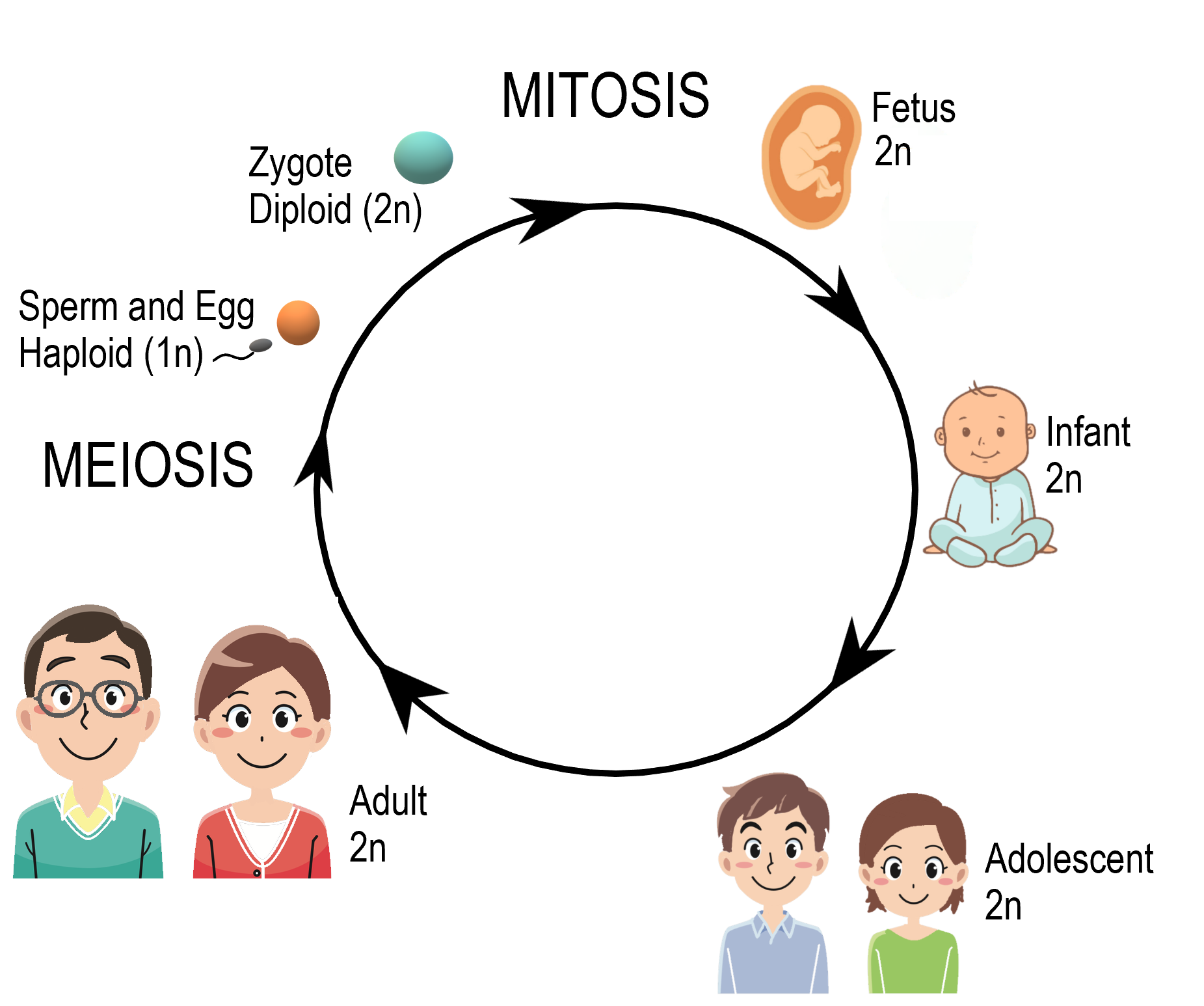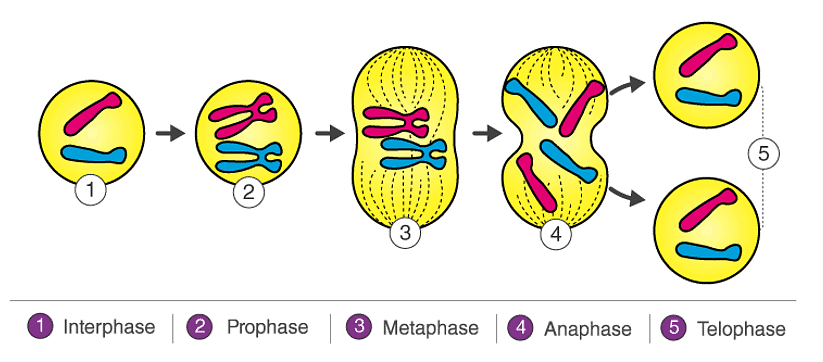Cell Division
Subject: Science

Overview
Genetics is the study of genes and their impact on living organisms. Chromosomes in an organism's nucleus duplicate and split during cell division to transfer traits to daughter cells. The environment and sex chromosomes determine sex and physical qualities. Mitotic cell division involves dividing a single cell into two daughter cells for tissue growth, development, and repair. Meiotic cell division, also known as reductional cell division, involves dividing a diploid mother cell into four haploid daughter cells, or gametes. Advancements in genetics have led to the creation of hybrid animals and the artificial reproduction of various animals.
Let's think:
- What do the lines in the cell's nucleus in the above image represent?
- What's the deal with creatures that have a resemblance to their parents?
- How can parental traits get passed down from one generation to the next in an organism?
- How is an organism's cell count increased?
- Why is a small piece of DNA being inserted and another being removed in the above picture?
Not everything that is alive lasts forever. When an organism reaches adulthood, it produces progeny that resemble it. All creatures have traits that are handed down from one generation to the next, which explains why all species' children look like their parents. This is the result of chromosomes located in the organism's nucleus. Chromosomes duplicate and split during cell division in order to transfer to daughter cells. The traits of parents are passed on to their children, and the environment is one of the many variables that affect an organism's ability to vary within its own species. The features of living things are determined by their chromosomes. The number of chromosomes and the millions of genes that are included in each chromosome determine an organism's features. The primary factor in determining sex is the sex chromosome. A living thing's physical qualities are determined by its genes, which also aid in passing those traits on to the following generation. Genetics is the area of biology that focuses on the investigation of genes.
Mendel established a number of genetic laws that facilitated a variety of genetic studies. Many technologies have been developed in the field of genetics these days. These have shown to be successful in a number of studies as well as in people's daily lives. The advancement of genetic engineering has enabled the creation of different hybrid animals as well as the artificial reproduction of a wide range of animals.
Cell Division
Prokaryotic cells are thought to have developed into eukaryotic cells, and over time, unicellular eukaryotic cells are thought to have gradually transformed into multicellular organisms. Gametes are formed during sexual reproduction when cells in the male and female reproductive organs divide through a process called meiosis. During mating or copulation, male and female gametes created in this manner combine to form zygotes. A zygote has only one cell. It goes through recurrent mitotic cell division to become a full body, which is the united form of several cells. The two steps of karyokinesis and cytokinesis mark the completion of both mitosis and meiosis cell division. The terms "cytokinesis" and "karyokinesis" refer to the division of the cell membrane and cytoplasm, respectively, and the nucleus. In a mitotic cell division, a mother cell divides into two daughter cells, while in a meiotic cell division, the mother cell divides into four daughter cells. Gametes are daughter cells that form at the completion of meiosis, while somatic or vegetative cells form at the end of mitosis.
Mitosis Cell Division
Every cell in the body, with the exception of reproductive cells, undergoes mitotic cell division. During mitotic cell division, a single cell divides into two daughter cells. The primary purposes of this kind of cell division are tissue growth, development, and repair. Every cell in our body, with the exception of gametes, is diploid and has two sets of chromosomes: maternal and paternal. 2n is a representation of such cells. The chromosomes in a cell's nucleus multiply and create two identical copies of DNA prior to cell division. Two identical daughter cells, each containing a copy of the DNA, are produced at the completion of cell division. This is the process by which daughter cells acquire the genetic traits present in their mother cells. Therefore, the number of chromosomes in the daughter cells produced by mitotic cell division remains unchanged. For this reason, equational division is another name for this kind of cell division.
Significance of Mitotic Cell Division
- Physical growth is mostly dependent on mitosis since it increases the number of cells with the same genetic composition during cell division.
- It aids in the regeneration of damaged tissue's cells, restoring them to their pre-damage state.
- Invertebrates and certain plants that reproduce asexually benefit from it.
- It keeps genetic stability intact.
Meiosis Cell Division
Only the mother cells of the testis and ovary, the two main reproductive organs, are capable of this type of cell division. One diploid mother cell divides into four haploid daughter cells, or gametes, in this type of cell division. A cell that has half as many chromosomes as its mother cell is called a haploid cell. The genetic composition of the daughter cells generated from the mother cell during meiosis varies slightly. The two steps of this cell division are completed.
The genetic composition of each chromosome alters as a result of the crossing-over event that takes place during the first phase between two non-sister chromosomes. They then split apart and arranged themselves into two haploid nuclei. In other words, karyokinesis is the splitting of a nucleus in half. The next step is cytokinesis, which produces two haploid cells. These haploid cells divide mitotically during the second phase.initially via cytokinesis and then by karyokinesis. Ultimately, meiotic cell division results in the formation of four cells. These cells exhibit genetic variation as a result of crossing over during the first stage of meiosis. The reason this division is also known as reductional cell division is that the daughter cells have half as many chromosomes as the parent cells. To create the gametes required for sexual reproduction, meiotic cell division takes place in the ovaries of adult females and the testes of adult men. A diploid zygote is created during sexual reproduction when the male and female gametes combine. An organism's entire body is formed during the zygote's mitotic cell division process.
Significance of Meiotic Cell Division
- An essential component of an organism's sexual reproduction is meiotic cell division.
- It introduces variation, which aids in evolution.
- It aids in repairing chromosomal abnormalities.
Things to remember
- Genetics is the study of genes, which determine an organism's physical qualities and traits.
- Chromosomes in an organism's nucleus duplicate and split during cell division to transfer to daughter cells.
- Cell division involves the division of prokaryotic cells into eukaryotic cells, which gradually transform into multicellular organisms.
- Mitosis cell division is responsible for tissue growth, development, and repair, with every cell in the body being diploid.
- Meiotic cell division is essential for sexual reproduction, introducing variation that aids in evolution and repairing chromosomal abnormalities.
© 2021 Saralmind. All Rights Reserved.





 Login with google
Login with google